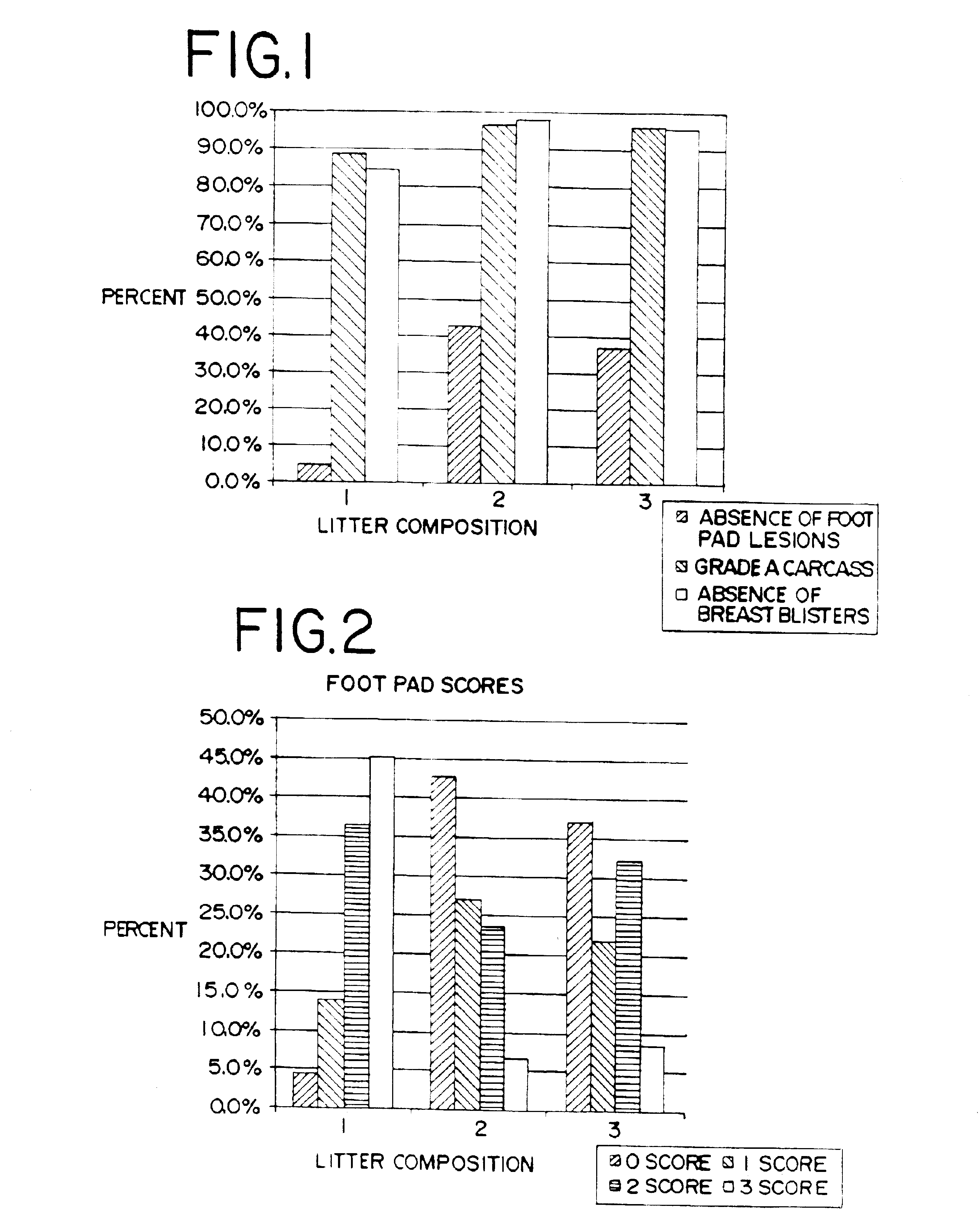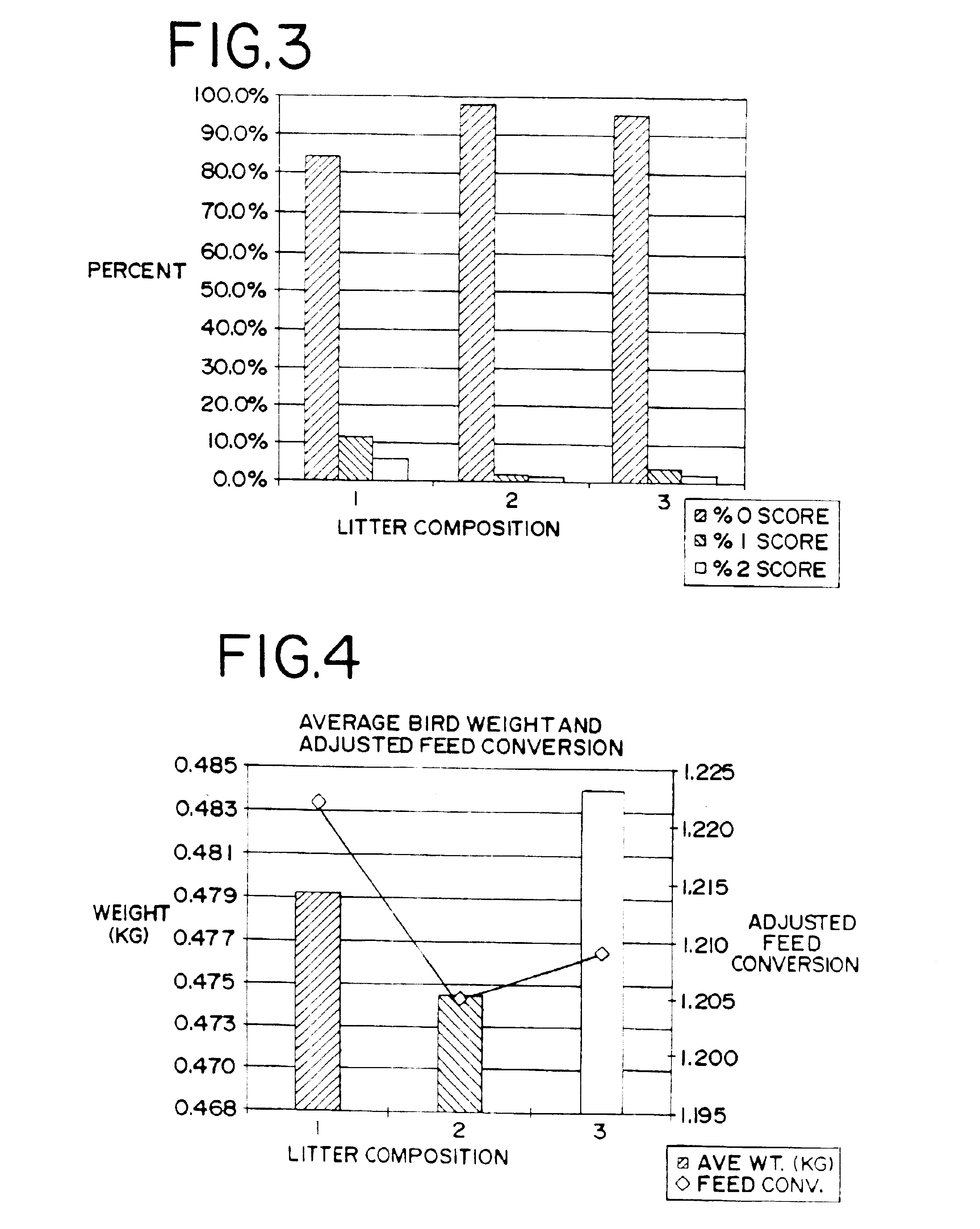Commercial poultry litter enhancement with citrus sources
a technology of citrus and poultry, applied in the field of commercial poultry litter enhancement with citrus sources, can solve the problems of affecting the effect of litter materials that cannot meet the needs of poultry raising, the effectiveness of reducing contact between birds and droppings is severely tested, and many litter materials fail in their intended function, so as to achieve enhanced bound ammonia content, reduce gaseous ammonia, and effect of binding ammonia
- Summary
- Abstract
- Description
- Claims
- Application Information
AI Technical Summary
Benefits of technology
Problems solved by technology
Method used
Image
Examples
example 1
A study was conducted to evaluate bedding litters within pens of the type typically used in poultry raising facilities. The testing was carried out over a typical growing period for broiler chickens, while monitoring certain parameters of importance to the poultry industry. The testing protocol strove to maintain all environmental, feeding and other conditions consistent for all birds, with the exception of the bedding litter composition.
Study Protocol
In accordance with typical industry practices, the diets for each pen were as follows. For days 0 through 19, the birds were given a 22% starter diet in crumbled form, the balance of to feed being typical basal feed material. For early feeding, 4,000 pounds of feed containing a coccidiostat feed additive (salinomycin at 50 grams per ton) were prepared. During days 19 through 35, a grower diet containing 20% pelleted grower feed formulation was combined with the basal feed containing the same feed additives and feed additive concentrati...
example 2
Another study was conducted to evaluate previously used bedding litters within pens of the type typically used in poultry raising facilities. The testing was carried out generally in accordance with Example 1 and included an additional analysis concerning a further matter of importance to the poultry industry, darking beetle and beetle larva populations. The testing protocol strove to maintain all environmental, feeding and other conditions consistent for all birds, with the exception of the bedding litter composition.
The study protocol was essentially as in Example 1, except the total number of pens used in the study was 40, with approximately 52 birds being in each pen at the initiation of the study. At day 7, each pen was targeted to have 50 birds, three different bedding litter compositions were used, and each composition was experienced by a target of 500 birds, there being 10 pens for each litter composition.
Soiled or used litter material from Example 1 was used for this study...
example 3
A study was conducted to evaluate bedding litters within pens of the type typically used in poultry raising facilities and generally as described in Examples 1 and 2. The testing was carried out over a 42 day growing period for broiler chickens. This study focused upon darkling beetle and larva control, as well as on ammonia control. Also, litter used in this study was utilized as used or pre-soiled litter for the study reported in Example 4.
The protocol for this study was substantially in accordance with the other Examples. Here about 45 birds were placed in each of 40 pens and fed and given water generally as in Example 2. Twenty of these pens contained fresh 100% pine wood shavings. These are identified as Compositions 1 and 4. Ten of the pens were designated to have Composition 2, which was 100% fresh dried citrus by product flake. The remaining ten pens contained Composition 3, which was 50% fresh pine wood shavings and 50% fresh dried citrus byproduct flake mixed together.
Beet...
PUM
 Login to View More
Login to View More Abstract
Description
Claims
Application Information
 Login to View More
Login to View More - R&D
- Intellectual Property
- Life Sciences
- Materials
- Tech Scout
- Unparalleled Data Quality
- Higher Quality Content
- 60% Fewer Hallucinations
Browse by: Latest US Patents, China's latest patents, Technical Efficacy Thesaurus, Application Domain, Technology Topic, Popular Technical Reports.
© 2025 PatSnap. All rights reserved.Legal|Privacy policy|Modern Slavery Act Transparency Statement|Sitemap|About US| Contact US: help@patsnap.com



